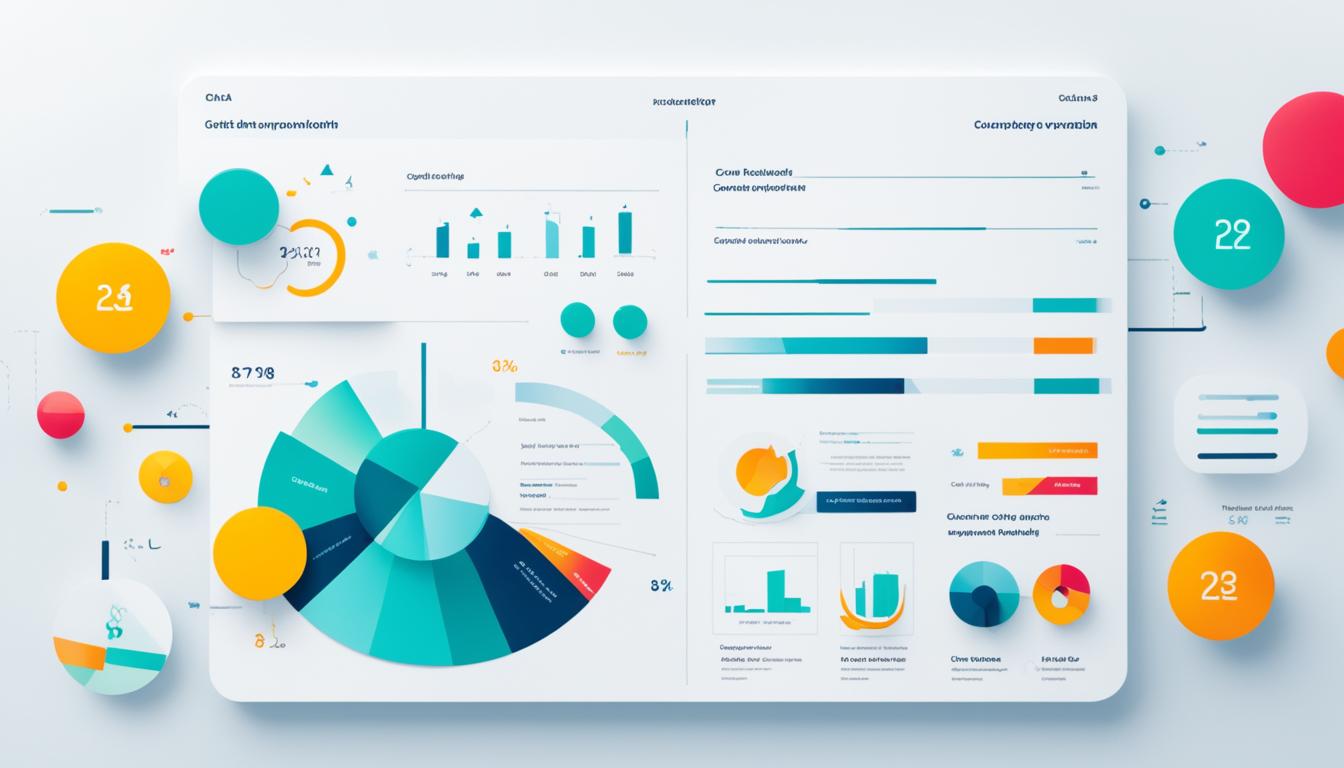Did you know companies using data-driven marketing are often more profitable each year? In today’s digital world, marketers need to use data insights for smart moves. These moves help connect with customers and grow the business.
Today’s marketers work with detailed knowledge to choose their next steps. They use special data sets from martech to make customers happy. But, they first need to know what the target customers’ needs are. Gathering the right data helps them set better prices, decide on strategies, and create goals they can actually reach.
With the right data insights, they can improve the marketing mix. This means better products, where to sell them, the right price, and how to talk about them. Doing this makes their product or service look good, fit into the market well, and reach people through the best channels.
Key Takeaways
- Leveraging data provides valuable insights into customer demographics, behaviors, and trends to inform marketing strategies.
- Data-driven personalization enhances customer engagement and boosts conversion rates.
- Analytics help optimize marketing channel allocation for improved ROI.
- Data insights can enhance the marketing mix to create a more compelling product or service offering.
- Data-backed decisions lead to superior results compared to relying on gut instinct alone.
The Importance of Data-Driven Marketing
Marketing success depends on data-driven strategies. Using data and analytics helps companies make smart choices, improve ads, and get better returns. Knowing your audience well with data analytics means you get to understand them better. You learn about their age, what they like to do online, and what’s popular now. This data lets you create content that really speaks to them. Knowing what works best also means you can spend your money and time wisely.
Understanding Your Audience Through Data
Studying audience data is key to making your marketing strategies work. With insights from data-driven marketing, companies can really get to know their customers. They find out what people like, how they act, and what matters most to them. This information helps marketers make campaigns that really connect with the audience. It drives a deeper relationship.
Personalization for Maximum Impact
Today, when there’s so much information out there, personalization is vital. By understanding customer data, companies can tailor their message directly to each customer. This makes the marketing feel more personal and on point. Not only does it get people more interested, but it also keeps them coming back for more. That’s how brand loyalty and keeping customers happy is secured.
Optimizing Marketing Channels
Good data-driven marketing also means picking the right places to promote. By looking at how customers act, how ads do, and specific numbers for each channel, companies know where to focus. This makes sure the energy and resources are spent where it matters most. It improves the chances of success.
Data Analytics: Uncovering Valuable Insights
In today’s world, data analytics is key to finding important info for businesses. It looks at large amounts of data to see patterns and trends. This helps make smart choices and plan marketing well.
Descriptive Analytics
Descriptive analytics looks at past data to understand what has happened. It gives a clear view of your business’s past. This lets you spot what’s working and keep an eye on trends.
Predictive Analytics
Predictive analytics uses the past to predict the future. It tries to guess what customers will want next. Marketers can then adjust their plans to try to meet these needs.
Prescriptive Analytics
Prescriptive analytics goes even further. It tells you what actions might be best for your marketing. It uses smart tech to give you clear suggestions based on data.
By using data analytics in these ways, businesses can improve a lot. They can offer better customer service and make their marketing more effective. This is really important in today’s competitive world.
Data Insights: The Key to Consumer Behavior
In our fast-changing digital world, data insights are vital for smart marketing. Marketers use consumer data to find priceless insights. These insights boost their knowledge of customer behavior and guide their decisions.
Data-Driven Decision Making
Data analytics is like a crystal ball for marketers. It gives them the information they need to make smart choices. For example, analyzing consumer data lets marketers see patterns. This helps them understand consumer actions. By knowing this, they can refine their marketing strategy and use their resources better. This leads to improved business results.
Mapping the Customer Journey
Map the customer journey. Start from first contact to final buy. This understanding is crucial. It lets marketers see which touchpoints affect consumer choices. With this insight, they can align their campaigns better. They aim to fix any issues and make the consumer experience better. Doing so builds stronger loyalty to the brand.
Predictive Analytics for Future Trends
With the right data, marketers can predict what consumers will want in the future. Using historical data and models, they forecast upcoming trends. Armed with this knowledge, they adjust their strategies early. This puts them ahead of their rivals. Such a proactive strategy helps businesses see and grab new opportunities. It keeps them in the lead.
| Metric | Impact |
|---|---|
| Businesses leveraging customer behavior insights | Outperform their peers by 85% in sales growth |
| Moderate increase in customer experience | Generates an average revenue increase of $775 million over three years for a company with $1 billion in annual revenues |
| Consumers with higher expectations in customer service (2017 vs 2016) | 54% increase |
| Consumers in retail expecting personalized experiences | 80% of respondents |
| Potential sales increase from properly executed CPG displays | Up to 193%, but only executed less than 50% of the time |
Marketers who use data insights better understand consumer behavior and can tailor their strategies with precision. They make decisions based on solid data. This creates experiences that really connect with consumers. A focus on data doesn’t just boost marketing. It also helps businesses anticipate and react to changing consumer trends. Thus, they pave the way for their long-term success.
Sales Data: Fuel for Marketing Strategies
Sales data holds a lot of numbers from the sales process. It shows why and how things sell. Important points are sales growth, annual revenue, churn rate, and more. This data helps managers know what changes to make for success.
By looking at sales data, marketing teams can predict sales better. They can see issues and improve connections with new and old customers. This approach helps companies make smart choices. These choices make their sales and marketing plans better.
| Metric | Description | Relevance to Marketing Strategies |
|---|---|---|
| Sales Growth | The percentage increase in sales over a specific time period. | Indicates the effectiveness of marketing campaigns and the overall demand for products or services. |
| Annual Recurring Revenue (ARR) | The predictable revenue a business can expect to receive each year from existing customers. | Helps determine the long-term viability of the business and guides strategies for customer retention and loyalty. |
| Churn Rate | The percentage of customers who discontinue their relationship with a business over a given period. | Identifies areas for improvement in customer satisfaction and the need to refine marketing approaches to enhance customer loyalty. |
| Net Revenue | The total revenue generated after deducting discounts, returns, and other adjustments. | Provides valuable insights into pricing strategies, product mix, and the overall profitability of the business. |
| Retention Rate | The percentage of customers who continue to do business with a company over time. | Helps evaluate the effectiveness of customer engagement efforts and guides strategies to improve customer loyalty and lifetime value. |
| Average Profit Margin | The percentage of revenue that remains after deducting the costs of goods sold and other expenses. | Informs pricing decisions, product mix optimization, and the allocation of marketing resources to maximize profitability. |
Using sales data, marketing teams can act on insights. They can make the sales process better and create sharp marketing plans. These efforts are key to winning and keeping customers. They also help grow the business at large.
Customer Data: The Foundation of Personalization
First, to create personalized marketing, businesses need to know their customers well. They gather and analyze data like who their customers are, what they do, how they interact, and what they think. Marketers use this to group customers and create content that attracts them to the brand.
Descriptive Data
This kind of data shows basic info about customers, like age and where they live. It’s the starting point to understand who the customers are. With this info, businesses can create profiles of their ideal customers.
Behavioral Data
Behavioral data looks at how customers act and use products or services. It includes what they buy, how they browse, and what they do with the products. Understanding this helps businesses improve their products and make the shopping experience better.
Interactive Data
Interactive data is about how customers like to connect with brands, like through social media. Knowing this, businesses can focus their efforts on the platforms their customers prefer. It ensures they’re using the right ways to interact with customers.
Attitudinal Data
Attitudinal data dives into what customers think and feel about a brand. It comes from surveys, reviews, and social media. With this data, businesses can adjust their messaging to connect more deeply with customers.
Businesses can combine all these types of data to get a complete picture of their customers. They use special tools to collect and manage data easily. This helps them create experiences that make customers want to keep coming back.
Competitor Analysis: Staying Ahead of the Game
Looking at the competitor analysis scene is vital. It helps spot market gaps. And it improves a company’s value proposition and market competition plan. Companies understand competitors’ strengths and weaknesses. This helps set their growth goals and choose good marketing approaches. For example, using funny ads or videos might win customers over more than blogs do.
The Publer Competitor Analysis tool is great for this. It shows important numbers about your competitors. Such as how many posts they make, how many followers they gain, and the kind of content they post. You can look at any time range you want, keeping your info fresh and current.
Publer’s tool offers detailed reports. You can get them as PDFs with charts or as CSV files for technical analysis. It’s a powerful way to understand what works for your competitors. This helps you make a stronger social media plan.
By checking what posts do well for competitors, you can learn a lot. You can find what types of content people like. And use this to get ideas for your own posts. Publer also helps you see the best times to post. This means more people could see your content.
Publer’s tool gives a big picture of social media use. It lets you stack your stats against others. This can show where you need to improve. And help you lead the way in your industry. The tool has been improved with help from Publer Ambassadors. This makes it a thorough competitive analysis tool.
| Metric | Publer | Competitor A | Competitor B |
|---|---|---|---|
| Posts in the last 7 days | 32 | 28 | 24 |
| Follower Growth | 5.2% | 3.8% | 2.9% |
| Engagement Rate | 7.4% | 6.1% | 5.3% |
| Reach | 62,400 | 53,800 | 47,200 |
| Top Content Type | Video | Images | Link Posts |
Using competitor analysis well keeps businesses in the lead. It helps find chances in the market. And makes sure you stand out against your rivals.
Market Research: Navigating the Business Landscape
Understanding a company’s place in the world is crucial. And that’s where market research steps in. It looks deep into the environment surrounding a product or service, giving essential insights. These insights help achieve various goals like making better marketing objectives or improving how the company is seen by the public. They also guide in choosing the best ways to promote and in creating new products.
Surveys, interviews, focus groups, and watching customers are typical tools in market research. With these, companies learn what consumers like, how they behave, and what they struggle with. This knowledge is key in making choices that match what the target customers really need.
| Market Research Technique | Purpose |
|---|---|
| Surveys | Evaluate consumer preferences and behaviors |
| Interviews | Gain in-depth understanding of customer needs and pain points |
| Focus Groups | Gather qualitative insights on product or service perception |
| Customer Observation | Analyze real-time customer interactions and behavior |
Using these tools, companies can stay competitive, spot new chances, and handle threats. This keeps them in the lead and lets them adjust to what customers want at any time.
Product Data: Enhancing Customer Experiences
In today’s world, knowing about products is key. It helps brands connect with people better and boost sales. This info can help a business get more customers, make more money, and keep shoppers happy. This, in turn, helps the company grow.
Product Adoption Rate
The product adoption rate is super important. It shows how well new things are doing with customers. Keeping an eye on this helps make the buying process smoother. This way, businesses can provide great service and keep people coming back.
Product analytics give live feedback on what customers do. This helps businesses improve their products and catch what customers want early. By tracking adoption rates, companies get better at marketing. They also tweak their products to fit what customers like. This all works towards giving customers a great, tailored experience.

Ethical Considerations in Data Analytics
Data analytics is changing how industries work. But, there are important ethical questions we must think about. Ethics in data analytics is key for businesses. They need to make sure they respect privacy, are clear about what they do, and are fair.
Privacy and Data Protection
One main issue with data analytics is how it uses personal info. Letting that info out can be very bad for people. It can lead to things like someone stealing your identity. To avoid this, companies need strong ways to protect data. They also need to get permission before using someone’s info. Making data anonymous is a big help in keeping privacy safe.
Transparency and Fairness
Privacy is not the only thing to worry about. Companies must also be clear and fair in how they use data. If they start with data that is wrong or biased, it can make things worse. This can lead to unfair results for people. Checking their methods for issues is important to keep things right. Companies should make clear how their systems work and be ready to fix any issues.
It’s vital for companies to do data analytics right. This way, they can keep their customers’ trust. They should focus on privacy, transparency, and fairness. This helps them make experiences that customers love. It keeps their customers happy and loyal.
Data Insights: Driving Marketing ROI
Data-backed insights are key to making marketing better and more cost-effective. They help businesses improve in many ways. This includes getting more leads and sales. Such strategies lead to more success. Using data insights is vital for making marketing work well and for offering customers experiences they’ll love.
Getting a good marketing ROI depends on using data well. Companies that focus on data make better choices. They can tailor their messages, pick the right channels, and make campaigns that really speak to people. This means they not only get more people interested but also make more from their marketing bucks.
| Key Metric | Benchmark |
|---|---|
| Average Marketing ROI | 5.3:1 |
| Increase in ROI with Data-Driven Strategies | 15% |
| Improvement in ROI with A/B Testing | 30% |
| Increase in Transaction Rates for Personalized Emails | 6x |
To really understand marketing success, businesses should track important goals. They should follow how consumers move through all stages of buying. With this full view and a keen eye on data trends, companies can do better. They can grow steadily and see more success in their marketing ROI.
“Leveraging data insights is essential for optimizing marketing campaigns and creating personalized customer experiences that drive loyalty and growth.”
Tools and Techniques for Data Analysis
In today’s marketing world, companies can use many methods and tools to understand data. They include stats, machine learning, data visualization, and monitoring social media. With these, companies can make smart, data-based choices to boost their marketing efforts.
Statistical Analysis
Techniques like regression and correlation analysis help spot links between different elements. Marketers get to know their audience better. This helps them plan their marketing more effectively.
Machine Learning
Machine learning can sift through piles of data to find patterns and predict future trends. Marketers are thus empowered to understand consumer behavior deeply, predict trends, and refine their campaigns to do better.
Data Visualization
Data visualization takes raw data and makes it easy to see and understand. This is done through charts, graphs, and dashboards. It speeds up the decision-making process by making information clear at a glance.
Social Media Monitoring Tools
Tools for monitoring social media watch conversations, feelings, and interactions online. They give marketers insights into their audience’s thoughts and actions. This knowledge helps them respond better with improved social media strategies.
Conclusion
Today, using data analytics and customer insights is crucial for marketing success. It helps businesses understand their audience better. With this knowledge, they can create marketing that speaks directly to people. This not only boosts customer engagement and loyalty but also helps in growing the business over time.
Ethics and privacy are important when using customer data. It’s vital to strike a balance between using data wisely and respecting people’s privacy. Finding this balance can lead to powerful, personalized experiences for customers. Such experiences can significantly increase a business’s return on investment (ROI) and ensure its success in a competitive market.
Every year, we’re producing more and more data. In 2012, the world’s data supply reached 2.8 trillion gigabytes. Being able to turn this vast amount of data into useful insights is a critical edge. Companies that put data and their customers at the heart of their marketing strategy will excel. They can offer unique customer experiences and achieve steady growth and profit in the digital world.
FAQ
What is the importance of leveraging data for marketing insights?
How can data analytics help businesses understand their audience?
What are the different types of data analytics?
How can data insights help businesses understand consumer behavior?
What types of sales data can be leveraged for marketing strategies?
How can customer data be used to personalize marketing efforts?
What is the purpose of competitor analysis?
How can market research help businesses achieve their goals?
What product data metrics are important for businesses to track?
What are the ethical considerations in leveraging data analytics?
How can data-backed insights improve marketing efficiency and ROI?
What are some techniques and tools for data analysis in marketing campaigns?
Source Links
- https://www.linkedin.com/pulse/leveraging-data-analytics-improve-your-marketing-strategy-agrawal-qzhzf
- https://improvado.io/blog/data-driven-marketing-decisions
- https://moldstud.com/articles/p-leveraging-data-analytics-for-marketing-insights
- https://www.semrush.com/blog/data-driven-marketing/
- https://www.vezadigital.com/post/the-power-of-data-driven-marketing-why-it-works
- https://www.qlik.com/us/data-analytics
- https://global.hitachi-solutions.com/blog/what-are-consumer-insights/
- https://www.linkedin.com/pulse/big-data-insights-understanding-consumer-behaviour-darren-nicholls-vejdc
- https://www.linkedin.com/pulse/power-data-insights-how-understanding-consumer-behaviour-empowers
- https://oneflow.com/blog/understanding-sales-data/
- https://kaizen.com/insights/data-analysis-marketing-sales/
- https://www.mckinsey.com/capabilities/growth-marketing-and-sales/our-insights/the-future-of-personalization-and-how-to-get-ready-for-it
- https://www.acquia.com/blog/why-effective-marketing-requires-foundation-unified-customer-intelligence
- https://publer.io/blog/publer-competitor-analysis/
- https://fastercapital.com/content/Competitive-analysis–Staying-Ahead-of-the-Game–Harnessing-Social-Listening-for-Competitive-Analysis.html
- https://www.linkedin.com/pulse/staying-ahead-game-power-competitive-monitoring-coresignal
- https://www.forrester.com/blogs/a-guide-for-understanding-the-marketing-analytics-landscape/
- https://radiusinsights.com/blog/market-landscape-research-brand-growth/
- https://rikkeisoft.com/blog/data-driven-customer-experience-guide-for-the-best-strategy/
- https://userpilot.com/blog/data-analytics-to-improve-customer-experience/
- https://www.fullstory.com/blog/data-analytics-to-improve-customer-experience/
- https://skillfloor.medium.com/ethical-considerations-in-data-analytics-balancing-insights-with-privacy-3b70e2b779c9
- https://www.linkedin.com/pulse/ethical-considerations-data-analytics-building
- https://www.xerago.com/insights/data-driven-marketing-strategies
- https://www.nielsen.com/insights/2024/data-driven-not-enough-roi-strategy-marketing-metrics-business-impact/
- https://logitgroup.com/strategies-for-enhanced-roi/
- https://careerfoundry.com/en/blog/data-analytics/data-analysis-techniques/
- https://www.stitchdata.com/resources/data-analysis-tools/
- https://www.nngroup.com/articles/data-findings-insights-differences/
- https://www.datapine.com/blog/data-interpretation-methods-benefits-problems/














